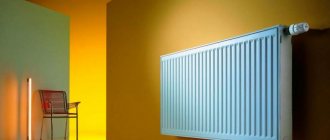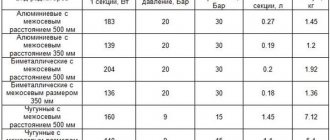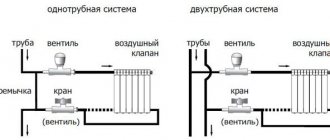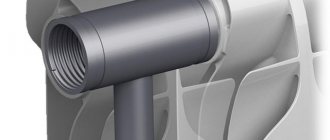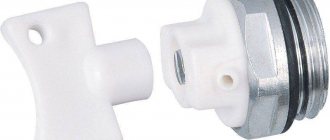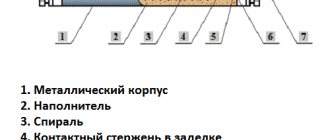Increasingly, when choosing heating radiators in a house, apartment or office, preference is given to tubular radiators. The popularity of such radiators is due to their high corrosion resistance, operating efficiency and aesthetic appearance.
They consist of upper and lower collectors, between which there are jumper tubes.
Laser welding is used to connect the elements, making the seams as neat and invisible as possible.
Radiators can be made of stainless steel, aluminum, or a structure of steel tubes placed in an aluminum housing (bimetallic).
Review of manufacturers
The presented range of tubular radiators is quite large.
On the positive side, models made by Russian manufacturers have proven themselves, since such partings are produced taking into account the specifics of water quality, pressure drops and a number of other nuances inherent in our region. In the list of foreign-made goods, you should opt for radiators made in Germany, Turkey or Italy.
Heating structures from Czech companies are notable for their low cost, as well as the high level of quality of the goods sold. A distinctive feature of the product is a special system that involves installing thermostatic valves in radiators, through which the temperature is adjusted, the values of which were indicated earlier. It is worth noting the very popular Czech brand of radiators Isan Atol.
In specialized stores you can find products from Turkish manufacturers who specialize in the production of steel radiators. The products have an affordable price, in addition, most of the companies operate under the license of popular European companies, thanks to which the heating devices produced fully comply with European quality standards, which puts them on a par with Russian-made devices.
The batteries, which are manufactured in Poland, belong to the mid-price category; the production facilities, which specialize in the production of heating devices, use the latest equipment during their work, as well as many years of experience, which has a positive effect on the quality of the finished product. Most of the radiators produced by Polish companies are presented on the market with bimetallic models. Among the popular brands is Termica.
Dia Norm and Zehnder companies are popular German manufacturers of tubular steel radiators.
In addition, it is German organizations that are actively involved in the manufacture and sale of devices that should be classified as part of the model range of non-standard radiators. For example, Zehnder products are available on the market in more than 700 colors. However, the disadvantages of such products include their high cost.
There are heating products of joint production, for example, products from Arbonia are very popular. As consumers note, Swiss-German radiators have an attractive external design, good performance characteristics for Russia, and also a very affordable cost of goods.
In the list of leaders regarding the technical characteristics of heating devices, it is worth highlighting Italian products for space heating systems. The only disadvantage of this product is its full compliance with European operating standards, which is not always acceptable for the Russian consumer. However, the ease of installation and high level of efficiency of heating devices make them very popular.
Among the popular Italian brands, it is worth highlighting the products of the Royal Thermo company, which has positive characteristics regarding the quality, care and service life of the devices. The disadvantages include the high cost of Italian heating products.
Purmo are radiators from Finland, which are manufactured in a wide range of sizes, as well as connection and installation options. In addition to standard models, the company produces devices according to individual sizes and designs; the price for such devices will be slightly higher than for regular products.
Tubular radiators made in China belong to economy class products. However, the low cost does not in any way affect the quality of the goods, since the batteries are resistant to aggressive substances contained in water, and some companies specialize in producing devices that are adapted to the needs of Russian consumers.
The best tubular steel radiators
Arbonia 2180 radiator series
An elegant series of tubular steel heating radiators from the German brand, suitable for rooms with high ceilings.
Characteristics of the model range
A series of tubular steel radiators are available with 6, 8 or 10 sections. Side or bottom liner available. The manufacturer offers two color options: white or metallic. The height of the structure is 1800 mm. Section length 45 mm. The 6-section model produces 990 W of power and weighs 16 kg. The largest radiator battery with 10 sections operates with a power of 1650 W and has a mass of 26 kg. All radiators in the series can withstand a working pressure of 10 atm with a pressure test of 15 atm. The maximum liquid temperature is allowed up to 120 degrees. The manufacturer provides a 3-year warranty on the product.
Design features
- the main feature of the model range is a strictly vertical design;
- radiators have a two-pipe configuration;
- Bottom or side eyeliner is possible;
- external thread for connection ¾ inch;
- construction depth 65 mm;
- center distance 1730 mm.
Purmo LaserLine 2180 radiator series
Beautiful double-tubular steel radiators from the Finnish brand. The series is represented by 8 models and can be painted in one of 9 colors, including black, blue, gray or red.
Characteristics of the model range
The series of tubular radiators contains models with 4, 5, 6, 8, 9, 10, 12 and 14 sections. The width of the most compact is 200 mm. Its heating power is 668 W. The weight of this model is 11 kg. The largest radiator has a width of 700 mm and a heating power of 2338 W. But such a radiator will weigh 39 kg. The manufacturer provides a 10-year warranty on all products. During testing, a crimping pressure of 18 bar is used, which allows the use of an operating pressure of 12 atm. Liquid temperature is allowed up to 120 degrees.
Design features
- the shape of the radiators is vertical, but the edges are rounded, so the model gives more comfort to the room and fits into any interior;
- lateral connection type (left-hand and right-hand);
- distance between fittings 1735 mm;
- section depth 63 mm;
- The height of all models is standard and is 1800 mm.
Arbonia 2057 radiator series
Low-rise steel German radiators for installation under windows. They are distinguished by their shallow depth, so they do not stick out from under the window sills.
Characteristics of the model range
The series of tubular radiators is presented in more than 20 variants, where the buyer can purchase models from 3 to 30 sections. The company even produces separate sections, so the radiator can be expanded if necessary. The heating power of each section is 67 W. The section weighs 500 g and has dimensions of 570x45x65 mm. The crimping pressure reaches 15 atm, so in normal operation a constant load of 12 atm is allowed. The manufacturer provides a 10-year warranty on the product. It is allowed to use coolant with an acidity pH of 7.5 and a temperature not exceeding 120 degrees.
Design features
- the series is notable for its narrow tubes, which helped reduce the depth of the case to 65 mm;
- Both bottom and side eyeliner are possible;
- distance between fittings 500 mm;
- connection thread diameter ½ inch.
Zehnder Charleston 2056 radiator series
Radiators of this series consist of two vertical steel pipes, made in the form of a rectangular profile. This gives them elegance and sets them apart from most competitors' products.
Characteristics of the model range
This series of steel radiators is available with 8, 10, 12, 14, 16 sections. The maximum indicator reaches 32 units. The parameters of each section are 48x56 mm with a depth of 62 mm. The design is made of low-carbon steel and weighs 890 g. The surface of the radiator is painted with powder paints according to RAL, where 9 color options are available. The test pressure is 16 bar. The operating indicator is at 12 atm. The manufacturer allows a coolant temperature of 120 degrees.
Decorative possibilities of tubular heating devices
Tubular radiators look very elegant and light.
There are non-standard versions available for sale. For example, semicircular. True, such models cost three times more than those that have a regular shape. An interesting design solution can be called tubular bench radiators. The color range of tubular steel devices is very wide. Most often you can find dark and light batteries on sale. Dark options improve heat transfer. But many consumers prefer more interesting color solutions. For example, bronze, metallic, lacquered wood, mother-of-pearl, aged bronze, etc. Chrome plated products also have good efficiency.
Such fashionable interior styles as vintage and loft have given rise to other interesting designs for radiators. For example, there are models in which the metal surface is treated with special means to increase anti-corrosion properties, and the top is coated with a transparent varnish.
Battery grilles are often used as design decoration. Such elements add aesthetics and also protect the radiator from various mechanical damage. The nets are sold in different shades. At the same time, the price of grilles for heating radiators does not depend on color.
Mounting methods
Tubular batteries are attached to the wall in the same way as all others - using brackets. The latter do not require reinforced fasteners, since the batteries, as mentioned, are quite lightweight.
Before installing the radiator, it is recommended to attach a reflective screen made of foil thermal insulation to the wall, which will reduce heat leakage through the building envelope.
Designer tubular radiator
If there is a window sill above the battery, especially a wide one, it is advisable to attach a smoothly curving canopy-fairing made of tin above the device, which will facilitate the movement of warm air rising from the battery and direct it into the space in front of the window (a thermal curtain will be formed).
Heating radiators often spoil the interior of the room. Tubular heating radiators will solve the problem with decor. Not only will they not spoil the external impression, but on the contrary, they will bring additional zest to the interior.
You will find a guide to installing heating batteries with your own hands here.
If there is no water heating, you have to use other options. Electric oil radiators are a popular alternative. Follow the link to learn more about the features of this type of device.
Subtleties of connection
The choice of installation method for tubular radiators is determined by the device model. There are several device options:
- universal devices - most of the tubular radiators sold have special holes for connecting to any type of heating system pipes;
- models of devices with a bottom connection method, in which all outlet and inlet communications are located outside the viewing area;
- the side type involves connecting the radiator to vertical heating risers;
- radiators with a cross connection type - in this option, the pipe supplying coolant is located at the top, and the outlet pipe is on the opposite side.
Heating devices are mounted on brackets suitable for the type; after completing all actions related to the installation of the radiator, it is imperative to perform pressure testing to eliminate the risk of leaks at the junction of pipes and the heating system. For tubular radiators, the most acceptable coolant temperature is considered to be not exceeding +120 C.
How to choose heating pipes
Deciding which pipes are needed for heating is not easy, so to maximize the efficiency of the selected materials, it is necessary to comprehensively consider their characteristics in relation to a particular system.
When choosing pipes, you need to consider the following factors:
- The power of the system and the pressure created in it;
- Pipeline installation method (external or internal);
- Type of heating system (natural or forced);
- Limit temperature of the coolant in the system;
- System configuration (simple or complex).
These factors provide most of the information necessary for selecting the optimal materials, but not all of it - for example, the coefficient of linear expansion of a pipe when exposed to temperatures depends specifically on the pipes. For the information to be complete, you need to know exactly which pipes are used for heating.
Previously, only metal pipes were used to lay heating system pipelines. This is not surprising, because there was no alternative, and it was impossible to think about what was better - steel pipes or polypropylene. Now there are many good analogues that are worth paying attention to.
Chinese
The most budget model of a metal tubular radiator can be called Oasis batteries made in China. Despite its low cost, the device is characterized by good durability, resistance to aggressive influences and the absence of operational restrictions. A number of models are manufactured taking into account the specifics of domestic heating networks. Oasis tubular heating radiators have the most positive reviews. The company also specializes in the production of standard bimetallic heating radiators, characterized by excellent thermal characteristics and affordable cost.
Which material is more suitable for underfloor heating pipes?
Metal-plastic pipes
Metal-plastic pipes are the first and most popular, until recently, polymer pipes for heated floors. If you look in section, such a pipe consists of two polymer layers, between which there is a layer of aluminum foil 0.2 millimeters thick or more. The most famous pipe for underfloor heating is the Henco pipe. It hasn't been very popular lately, because... the cost of the pipe is quite high. Through the use of cross-linked PEX polyethylene and high-quality adhesive for gluing the layers.
Unlike Henco, other European manufacturers have switched to the production of metal-plastic pipes made of heat-resistant polyethylene PE-RT. The elongation of this material when heated is several times less than that of PEX cross-linked polyethylene ; therefore, the reliability of such a pipe during sudden temperature fluctuations is higher. So, many Chinese manufacturers use cross-linked polyethylene, and taking into account the savings on other materials, the overall quality of the pipe turns out to be quite low, which is why there are a lot of bad reviews on the forums about delaminating pipes and a cracking outer layer (they are afraid of ultraviolet radiation).
The presence of aluminum foil in the composition of a metal-plastic pipe allows you to completely avoid the ingress of oxygen into the coolant and reduce the linear elongation by up to 5 times.
If you decide to use a metal-plastic pipe, it is better to focus on European manufacturers
- Uponor (PE-RT/AL/PE-RT) Germany
- SANHA (PE-RT/Al/PE-HD) Germany (Application up to operating class 5)
- HENCO (PEXc/AL0.4vmm/PEXc) Belgium
- APE, STOUT (PEXb/Al/PEXb) Italy
- COMPIPE (PEXb/Al/PEXb) Russia (Application up to operating class 5)
- Valtec, Altstream, etc. Russia-China
XLPE pipes
Cross-linked polyethylene is the most popular material for underfloor heating pipes at present. We will not dwell on the description of this material, because... There’s enough information to fill an entire article, but we’ll tell you which pipe options are best to choose.
The highest percentage of crosslinking (from 75%) in the peroxide crosslinking method is PEXa pipes. The most expensive method used by European manufacturers. The silane crosslinking method of PEXb is the most common, the level of crosslinking is quite high, but for example in the USA such pipes are prohibited for use due to the presence of harmful chemical compounds. It is also believed that a PEXb pipe gains its strength properties only during operation of the pipe with coolant.
By exposing the material to charged particles, 60% cross-linked PEXc polyethylene is obtained. The product is irradiated in the solid state. The main disadvantages of the method are the heterogeneity of the material as a result, but there are also advantages - cross-linked polyethylene gains increased elasticity.
As the degree of crosslinking increases, strength, heat resistance, and resistance to aggressive environments and ultraviolet rays increase. However, along with an increase in the degree of cross-linking, the fragility of the resulting pipeline increases and the flexibility decreases. If you increase the degree of crosslinking of polyethylene to 100%, then its properties will be similar to glass.
The biggest problem in choosing a specific manufacturer and pipe is the low quality of stitching in Chinese-made pipes, as well as in some Russian representatives. Another disadvantage of such pipes is the rigidity of the pipe; it does not hold its shape well and after bending it tries to take its previous shape and therefore it is more difficult to work with it than with a metal-plastic pipe, especially for an inexperienced installer.
The disadvantage of PEX material is that it is oxygen permeable. Water in pipelines without oxygen protection becomes saturated with oxygen after a certain time, which can lead to corrosion of system elements. To reduce the oxygen permeability of PEX, a thin layer of polyvinylethylene (EVOH) is used. The PEX base layer and the EVOH layer are joined together with glue. It is worth noting that the EVOH layer does not completely prevent oxygen emission, but only reduces oxygen permeability to 0.05–0.1 g/m3 day, which is acceptable for heating systems. In a PEX-EVOH pipe, the anti-diffusion layer is made on the outside, i.e. The pipe has a three-layer construction: PEX-adhesive-EVOH. Five-layer (PEX-adhesive-EVOH-adhesive-PEX) pipes are also available on the market, but tests have shown that the three-layer design is more reliable. The belief that the outer layer of EVOH in a three-layer construction is susceptible to abrasion is erroneous.
Another disadvantage of PEX pipes is their large linear elongation, so such pipes are practically not used for external installation, but only for hidden ones.
One of the advantages of pipelines made of cross-linked polyethylene is the presence of a memory effect. The shape memory effect is very useful during installation. If a kink, compression or other deformation occurs during pipeline installation, it can be easily eliminated by heating the pipeline to a temperature of 100–120 °C. (However, in the passport for the Russian-Chinese Valtec pipe it is written: “If there is a “break”, the damaged section of the pipe must be removed.”)
Wrinkles form on pipelines coated with an anti-diffusion layer after restoration. In these areas, the anti-diffusion layer peels away from the PEX layer. This defect has virtually no effect on the characteristics of the pipeline, since the main load-bearing capacity of the pipeline is determined by the PEX layer, which has been completely restored. A slight peeling of the anti-diffusion layer does not significantly increase the oxygen permeability of the pipeline.
Pipelines made of cross-linked polyethylene, and especially PEXa produced in Europe, are better suited than other polymer pipes for use not only in underfloor heating, but also in radiator heating, using the hidden method.
What pipes can be found on sale:
- UPONOR COMFORT PIPE PE-Xa EVOH Germany (use up to operating class 4)
- UPONOR COMFORT PIPE PLUS PE-Xa EVOH Germany (use up to class 5, underfloor heating and radiators)
- STOUT PEX-A Spain (use up to operating class 5) BEST CHOICE for PRICE-QUALITY
- SANEXT “Warm floor” PE-Xa Russia-Europe (use up to 4th class of operation)
- Valtec PE-Xb EVOH Russia-China (use up to operating class 4)
Heat-resistant polyethylene PE-RT
Very often, heat-resistant polyethylene PE-RT is called cross-linked polyethylene. But the production technology of such polyethylene is as follows. In the chemical reaction, “flat” butene is replaced by octylene (formula C8P16), which has a spatially branched structure. Subsequently, it forms side branches near the main chain, which are mutually intertwined monomer chains. They are connected to each other due to the mechanical interlacing of branches, and not due to interatomic bonds.
PE-RT pipes are mainly used for underfloor heating, where the temperature and pressure are lower than in water supply and heating systems. Although the manufacturers of PE-RT pipes, when pursuing their marketing policy, claim that the properties of their pipes are the same as those made from PEX cross-linked polyethylene. However, this is questionable because PE-RT is a conventional thermoplastic with limited overall resistance to elevated temperatures and pressures in hot water systems, as evidenced by hydraulic testing and subsequent practice.
A comparison of regression curves obtained by the independent Bodycoat Polymer Institute (Belgium) suggests that the durability of PE-X pipes is higher, and the regression curve, showing the loss of ability to perform work functions over time, for heat-resistant polyethylene PE-RT has a characteristic break (loss of strength during long-term operation) already at 70 °C.
- BioPipe (PERT) Russia
- RosTurPlast 16×2.0 PE-RT (type 2) (Russia) The most affordable option with high quality
Stainless steel and copper pipes
These types of pipes are practically not used in the installation of heated floors, and the main reason is the high price. Due to the fact that polyethylene pipelines from the best German manufacturers are 2 times cheaper than metal pipes, and their service life is more than 50 years (in a heated floor), there is no need for such pipes. Installation of a copper pipe floor is more expensive and the installer of such floors must have extensive experience and qualifications.
German
It is especially worth noting the high quality of tubular steel radiators from the German company Zehnder. The products of this company are distinguished by significant technological diversity, with the ability to connect to hot water pipes, open water heating systems and electrical circuits. German plumbing companies specialize in non-standard heating devices. Such models can be very high or super low, with a very rich range of colors (700 shades). The high cost of Zehnder products should be taken into account.
Speaking about German radiators, it is worth mentioning the Swiss-German enterprise Arbonia. These products are distinguished by excellent design, high technical characteristics and quality. At the same time, the cost of Arbonia heating appliances is quite acceptable for domestic buyers.
Radiator design
Steel tubular radiators can be made to order.
Steel tubular radiators can be made to order. The client can choose the dimensions of the device, its appearance, colors, technical characteristics and other important parameters.
On sale you can find products of different designs. Such models are both a heating device and a stylish decorative item. They can be built into furniture, benches, bar counters.
Based on the arrangement of the tubes, vertical and horizontal radiators are distinguished. Vertical models are characterized by a height of up to 3 meters and a small width. Tubes are most often also placed vertically in sections. Such tubular bimetallic radiators are actively used in places with limited space - stairwells, near balconies, in rooms with stained glass. Horizontal devices have a small height and a large width. Tubes can be installed horizontally or vertically. Connection to the heating system is made laterally.
Adviсe
Before installing aluminum systems, it is recommended to wash them, the main thing is not to use alkali for this. The wall on which the battery is hung is additionally reinforced. In addition, it is necessary to additionally finish it with fire-resistant material, for example, apply special plaster. This type of finishing will increase the fire resistance of the surface, but will not increase its thickness.
The attachment points must be evenly distributed over the entire surface of the battery, be strong, without defects or damage. Oil models can only be installed in places where the risk of fire is minimized. Such systems cannot withstand mechanical damage, so it is better to protect them with a special mesh.
See the next video for more details.
Calculation of power parameters
To carry out calculations, the temperature indicator for heating the coolant is useful. It is determined by the area of the room and the heating mode of the rooms.
For simplicity, the formula Q = St x K xt is used, where:
- Q is the design power of the heat pipe;
- St (m2) – heat exchange area;
- K – heat transfer coefficient of a steel pipe, the default indicator is 11.63 W/m2 x C;
- t – thermal pressure.
And now the calculations themselves - first determine the length of the pipe along the outer edge, multiply the indicator by the length of the section, then find half the sum of the temperatures in the supply and discharge pipelines - this is the thermal pressure parameter. Subtract the room heating temperature from the final result.
Important! Considering that the pipes are connected in parallel, water is transported sequentially through all registers, the heat transfer in each subsequent section of the pipeline will decrease by 10%, therefore it will be necessary to make adjustments and reduce the power of each subsequent section by 10%.
Pros and cons of tubular batteries
Before you buy tubular heating radiators, you need to consider what advantages and disadvantages they have.
Among the advantages of using these heaters are:
- Resistant to the negative effects of hard water. Corrosion plaques practically do not form on such batteries.
- Variety of colors and shapes. This allows you to choose a model that will ideally suit the design of the room.
- Safety. The device has no sharp corners. An excellent option for families with children. Such radiators are less dangerous.
- Easy to use and maintain. Due to their design, tubular batteries do not accumulate dust. They are very easy to wash.
- Modern models can be connected both via the bottom and side circuits.
- Only modern materials and the latest technologies are used for production.
The reviews for steel tubular heating radiators are very good. Many users note the following advantages of tubular batteries: ease of regulating the water supply, the ability to install on drywall, optimal price-quality ratio.
But heating devices also have some disadvantages:
- Low power. Because of this, tubular steel batteries can only be installed in small buildings and the private residential sector.
- The level of heat transfer is low.
- Expensive. Since this type of heating device appeared on the market relatively recently and new materials and technologies are used for its production, prices for steel tubular heating radiators are still quite high.
- Leaks may occur in areas where tubular welding has been carried out.
Copper pipes
Copper pipes are a rather unusual and very rare phenomenon. They seem to have a lot of positive qualities, but there is one serious drawback - too high a cost. It is because of this that copper pipes are practically not used when laying heating systems.
If we talk about the advantages, then their list will look like this:
- Ability to work in a wide temperature range - copper can withstand temperatures up to 500 degrees and can easily survive negative temperatures;
- Good resistance to high pressure (copper can even withstand water hammer);
- Durability - copper pipes can work without problems for more than a hundred years;
- Excellent visual qualities that only improve over time.
Of course, copper pipes can be used for heating, but this will be very expensive, so first you should consider all types of pipes for heating a private home - perhaps there is a more affordable material whose characteristics will be sufficient to solve a specific problem.
Positive and negative qualities
Choosing a tubular heating radiator involves first of all studying all its qualities. Both advantages and disadvantages must be taken into account, only then the choice will be competent.
Here are what are most often considered to be the advantages of tubular options:
This type of radiator is resistant to corrosion and is not destroyed by hard water.
An extensive range of design solutions for Russian and foreign tubular heating radiators allows you to choose any model.
No sharp corners that can lead to injury, which is very important for families with children
Caring for such radiators is easy, because they do not accumulate dust.
Although this variety has a lot of advantages, it is not without its disadvantages. The most annoying thing on the list of shortcomings is the high price of tubular heating radiators.
In addition, they have low power and poor heat dissipation. And also in some cases, leaks were noticed in places where pipes were welded.
Advantages and disadvantages
One of the advantages of tubular radiators is the absence of sharp corners
. Tubular heating radiators are a relatively new source of heat for country houses and apartments. They have a number of positive features that distinguish them from classic heaters:
- Easy to install. Self-installation is possible without the help of a specialist.
- Heat is distributed evenly compared to conventional radiators.
- Safety.
- Long service life. High build quality ensures long service life.
- No sharp corners, minimizing the number of injuries.
- Easy to maintain and maintain.
- Wide range of models. It is possible to select a radiator for a specific interior of the heated room.
Minuses:
- Low heat transfer. Inherent in cheap models with a small number of tubes in a section.
- Price. Tubular radiators are more expensive than classic radiators.
- A breakthrough may occur at the welding site in the event of a sudden surge in pressure.
- Limitation of the area of effective and safe use.
Pressure surges are typical for heating systems in apartment buildings. For this reason, experts advise installing tubular radiators in private houses where there is an autonomous heating system.
Design features of tubular batteries
In their design, tubular batteries are a bit like cast iron ones.
You can read more about cast iron heating radiators here. They just look thinner and much more elegant. Such equipment consists of lower and upper collectors connected by steel tubes. The elements are connected using universal laser welding. Thanks to this, the seam is neat and almost invisible. All tubular steel radiators have a very durable design. Thanks to the variety of sizes, shapes, and color shades, such a heating device will fit into any apartment interior.
Where can tubular radiators be installed?
Steel tubular radiators are usually installed in private houses or in apartments of five-story buildings.
Because water hammer often occurs in the central heating network. And the working pressure of a steel tubular battery is only 6-10 atmospheres. In the event of serious pressure surges, no specialist can guarantee the tightness and safety of the installation. In private homes, the operating pressure ranges from 6 to 8 atmospheres. Even if a water hammer occurs, the steel device will withstand such a load.
Tubular steel heating radiators are often used in medical institutions. This is explained by the fact that the batteries have excellent hygienic properties and are not hazardous. The device is characterized by the absence of corners and smooth bends. Dust does not accumulate on such radiators. And their wear resistance is much higher than that of their cast iron counterparts.
Characteristics of Tubular Steel Batteries
Tubular heating radiators are most often made of steel. Steel tubular heating radiators are very popular, because steel is a strong and reliable metal.
The main technical parameters of steel tubular radiators include:
- Height. Located within 30-300 cm.
- The number of tubes is not limited. There are options with one tube. And there are also with a much larger number.
- Depth is about 22.5 cm. There can be from 1 to 6 elements in a row in depth. For tubular steel radiators, the price depends on the working volume and parameters of the tubes.
- Sectional distance. Available in two versions: 6.5 and 4.5 cm. Batteries with a step between sections of 6.5 cm are more often used in hospitals, schools and other institutions where the requirements for the absence of dirt and dust are very high.
- The wall thickness varies from 0.1 to 0.2 cm. For imported models, the standard thickness is 0.1-0.15 cm. For domestic analogues, this parameter is slightly larger - 0.2 cm.
- In the classic version, the section section is round. The diameter is about 2.5 cm. However, pipes with flat, rectangular, oval and triangular cross-sections are also found on sale.
Types of tubular batteries
Depending on the location of the tubes, the equipment can be of two types: horizontal and vertical.
Horizontal ones are more often used in spacious office spaces. But vertical tubular heating radiators are actively installed in private homes, hospitals and schools. Thanks to their design features, vertical models visually raise the ceiling and do not accumulate dust. Depending on the shape, the heating device can be angular, flat, radius or designer. The corner model involves dividing the radiator into two sections, which are located at an angle relative to each other. You can choose any angle. With the flat version, the tubes are arranged in one row. This is the most popular form among buyers. The radius device has the shape of an arc. Quite an interesting solution. The designer type heating device is particularly original. Vertical pipes can be bent to create a wave-shaped structure.
Effect of characteristics on efficiency
A well-designed pipeline design has a positive effect on the performance of the heating system. The throughput of the structure depends on the cross-section of the components. The parameter shows the volume of hot liquid that will pass at a constant speed per unit of time.
Utility network performance is often influenced by factors. The efficiency of the circuit depends on 4 circumstances:
- Throughput and heat dissipation. The characteristic depends on the amount of water in the system.
- Pressure. The parameter in the heating network is associated with temperature and speed.
- Heat loss. At the joints and on the bends there will be a decrease in performance.
- Noise. The faster the fluid moves, the louder the sound.
In a heating system, with a constant flow of coolant and a decrease in diameter, the rate of water movement increases. On lines with a small cross-section, the fluid velocity will increase. Due to the low pressure in large structures, the flow rate is reduced.
Heat pipe diameter Source mastergrad.com
If the diameter of the pipes for heating a private house is too large, then the power of the pump built into the boiler will not be enough to move it. In a large system there will be a lot of coolant, so the equipment will not be able to cope with the movement of such a volume of liquid. Heating excess water will require spending more energy and time, which reduces the efficiency of the network and increases losses. As moisture passes through all rooms, it cools quickly.
The overall section is prohibited from being used in systems with natural circulation. When the speed is reduced, there is a risk of stopping and boiling the liquid in the heating boiler. With a small diameter, moisture can rupture the utility network.
What is affected by the size of parts Source ekaterinburg.kassot.com
When the speed decreases to 0.25 m/sec, air pockets often appear in the pipes. If the flow speed is more than 1.5 m/sec, then noise appears in the heating system. If the background noise standards are constantly exceeded, the inhabitants of the cottage will find it uncomfortable to live.
Installation of heating devices Source realstroyservis24.ru
Decorative benefits
Tubular radiators are characterized by special elegance and lightness. If desired, you can find models of non-standard configuration (semicircular sections, bench radiators, etc.), the cost of which is an order of magnitude higher. It is especially worth noting the wide range of colors of tubular steel appliances.
The most popular are light and dark solutions. Dark radiators have better heat transfer. Bronze, metallic, lacquered wood, mother-of-pearl, and aged bronze are considered more interesting color options. Good efficiency is observed in chrome-plated products.
In such popular interior styles as vintage and loft, you can also find more original designs of heating devices. In some cases, special anti-corrosion substances are applied to the metal surface.
Transparent varnish is used as a finishing touch. An example of design is the use of grilles, which makes the radiator more aesthetically pleasing. In addition, this creates additional protection against mechanical influences. You can choose a mesh of almost any shade: the price remains stable.
Advantages of tubular models
Heating devices of this type have more advantages than disadvantages, but the latter must also be taken into account. The advantages include:
- Simple but reliable design. Welding seams guarantee no leaks.
- Ease of installation. Radiators are lightweight and do not require special skills to connect.
- Increased resistance to corrosion. There are also models with a polymer coating on the inner surface. It is preferable to install such batteries in apartment buildings where the quality of the coolant leaves much to be desired.
- Increased heat transfer. This figure for tubular radiators is higher than for any other models.
- Resistant to high pressure. These devices operate without problems at 10-15 atm. This makes it possible to install them in apartment buildings - up to 9-10 floors high.
- Large selection of models. Design features allow you to choose a radiator for a room of any shape and size.
- Safety. There are no sharp corners in the design, so they can be installed in any room, including children's rooms.
Radiators can be of any shape - from standard straight models to intricately curved ones
Of the minuses it is worth noting:
- Quite a high cost of design options.
- Impossibility of installation in high-rise buildings where the pressure exceeds 10 atmospheres.
- Models with thin welded seams (this mainly applies to exclusive designer types) are not resistant to water hammer, so they are recommended to be installed only where there is individual heating with low pressure.
Tubular radiator design
Unlike the old cast iron versions of tubular batteries, modern designs are much nicer and better made. They represent two functional compartments: upper and lower.
These compartments are connected to each other by special steel pipes. Tubular steel radiators of modern models look very miniature and cute.
Despite their strength, steel tubular radiators are not able to withstand large pressure drops. For this reason, their installation is recommended only in private houses or five-story apartments.
In large high-rise buildings there are often unexpected power surges that exceed 10 atmospheres.
Tubular steel radiators are very popular in medical institutions. This is easily explained, because tubular batteries do not contain any corners that can cause injury.
In addition, tubular radiators do not attract dust and do not require special cleaning. For hospital and outpatient facilities, these qualities are most important.
Stainless steel pipes
Stainless steel pipes are a very good replacement for expensive copper pipes, having most of the same positive qualities at a relatively low price.
The advantages of this material are as follows:
- High resistance to pressure (maximum performance is demonstrated by seamless products with thick walls);
- Long service life;
- High thermal conductivity;
- Ability to work at high temperatures (stainless steel pipes can transport even heated steam);
- Excellent strength properties;
- Low cost (relative to copper products).
Stainless steel pipes are available in two forms - seamless products and products with a welded seam. The latter are made by welding and are sheet steel rolled into a pipe. The price of such products is lower, but you have to pay for it with a shorter service life.
Understanding which steel pipes are better for heating, you can come to a clear conclusion - these are seamless pipes that demonstrate the best qualities. Products with thin walls are almost equal in performance parameters to copper ones - and the difference in price is more than noticeable.
Heating market overview
The range of tubular steel batteries is very wide. You can buy either a radiator with a conventional design or a model that is a real work of art. The choice of companies and models is large and varied. It is best to buy Russian-made tubular heating radiators: domestic models are manufactured taking into account the climate, the quality of local water, frequent pressure changes and other important factors.
Among imported models, it is better to give preference to German, Czech, Turkish, Polish and Italian manufacturers.
Czech radiators
When considering Czech heating radiators, one should note the good quality of the products and relatively low cost. A feature of Czech-made batteries is a patented system for installing integrated thermostatic valves. Thanks to the valve, the temperature is adjusted according to preset parameters. Among Czech-made tubular radiators, Isan Atol products are in demand.
Turkish radiators
Turkish batteries are also of good quality. But it should be noted that Turkey produces mostly steel heating radiators of the panel type. The prices are quite affordable. Many models are manufactured under license from well-known European manufacturers. Therefore, the products generally comply with European quality standards.
Polish radiators
Inexpensive batteries are also available from Polish manufacturers. It should be noted that Poland has been producing bimetallic heating radiators for a long time. Thanks to many years of experience and improved production technology, prices for heating equipment are low. At the same time, the technical characteristics and quality are quite good. Among the Polish companies that specialize in the production of bimetallic radiators is Termica.
German radiators
Zehnder tubular heating radiators from a German manufacturer are of high quality. Depending on the type of connection, such batteries can be of different types: connected to hot water supply pipes, for open water heating systems and electric.
The German company specializes in the production of non-standard heating devices.
There are extremely high and super low models. The color range is varied - more than 700 shades. True, the cost of Zehnder heating radiators is very high.
The Swiss-German company Arbonia also produces durable, reliable products. Despite the remarkable design, high technical characteristics and excellent quality, the price of Arbonia heating radiators is quite acceptable for Russian buyers.
Finnish radiators
Purmo radiators made in Finland are also distinguished by their attractive design and good quality. Prices for Purmo heating radiators depend on the specific model and size. But, as a rule, the cost is quite affordable. The products are available in a large number of standard sizes and installation methods. You can choose the appropriate option for any room. It is possible to order a non-standard battery option. True, the price for such Purmo heating radiators will be slightly higher than for the standard model.
Chinese radiators
A more budget-friendly option is Oasis batteries made in China. Despite its availability, the product is very durable, resistant to aggressive substances and has no restrictions on use. Some models are manufactured taking into account the characteristics of Russian heating networks. Reviews for Oasis heating radiators are usually good. The company also produces bimetallic heating radiators, which we wrote about. Many note the excellent heating and affordable price.
https://youtube.com/watch?v=r0jbGAs22l8
Which pipes are best to choose for radiator heating at home - review of materials and manufacturers
The basic information you need to know about pipes both for radiator heating and for other systems (warm floors and water supply) is the pipe manufacturer, pipe marking and country of production . It doesn’t matter what material the pipe is made from, if it is not produced using technology, with savings on the quality of raw materials and quality control, such a pipe will not last long. And as with other products, a good pipe for heated floors cannot be cheap. Therefore, one of the most important issues when choosing a pipe is the question of choosing a specific manufacturer and the place where this pipe is produced. We recommend European manufacturers, so look for the words Made in .. on the pipe, if they are not there, it means that the pipe was made anywhere, but most likely in Russia or China.
Installation
The installation of steel tubular batteries is in many ways similar to the installation of traditional models and is not very difficult if you have theoretical knowledge and practical skills.
List of tools required for work:
- screwdriver;
- impact drill or hammer drill;
- adjustable wrench;
- pliers;
- roulette;
- building level;
- pencil.
Installation steps:
- Removing the old battery.
- Marking and installation of mounting brackets. Steel tubular radiators are heavy, so it is necessary to use brackets with appropriate load capacity.
- Tubular radiator canopy and installation kit assembly.
- Installation of a shut-off valve, a valve for a thermal head and a Mayevsky valve.
- Connection to heating system pipes.
- Crimping.
Connection method
Most models are connected to the heating system using the bottom or side method. The choice of connection method is influenced by the characteristics and features of a particular model, as well as the features of the distribution of heating pipes in the premises.
The bottom connection method is that both the supply and return pipes are connected to the radiator from below. With a side connection, the supply and return pipes are connected to the left or right side of the battery, depending on the model.
Conditions for correct installation
Regardless of the characteristics of the radiator, for its effective operation during installation it is important to ensure the following conditions:
- Distance between the top edge and the window sill (for horizontal models): 5-10 cm.
- Distance between the bottom edge and the floor: 9-12 cm.
- Distance between the wall and the radiator: 2-5 cm. In the case of installing a reflective heat-insulating layer, mounting brackets of increased length will be required.
Installation features
To install the radiator, you may need a screwdriver.
Self-installation of steel pipe radiators is similar to the installation algorithm for classic models. With minimal skills and abilities, even a home craftsman can carry out the installation with his own hands without the help of professionals.
To work, you will need the following tools, which should be in every home:
- screwdriver;
- perforator;
- pliers;
- key;
- roulette;
- level;
- simple pencil.
An impact drill can be used instead of a hammer drill.
The installation algorithm depends on the mounting method - wall or floor. Wall-mounted is considered the most convenient way to install any radiators. In the case of tall models, another method is not acceptable. Fixation is carried out on the wall using special fasteners. When installed on the floor, the product is placed on special feet on the floor. This method is suitable for installing wide and low models of tubular steel radiators.
Removing the old battery
Installation consists of the following steps:
- Removing the old battery. Dismantling must be carried out carefully so as not to damage the heating system.
- Marking of fasteners and their installation. It is important to choose the right brackets, since steel radiators are heavy. The load for which the clamps are designed must be appropriate.
- Radiator canopy on fasteners.
- Assembling the installation kit.
- Installation of taps and valves.
- Connection to the heating system.
- Crimping.
Next, the assembled system is tested.

